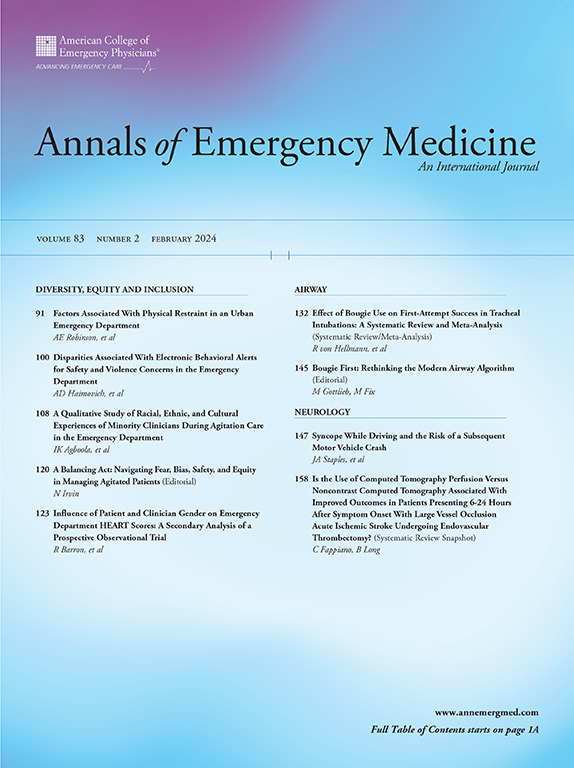鼻内与皮下氯胺酮治疗急诊科急性创伤性疼痛:一项随机临床试验
IF 5
1区 医学
Q1 EMERGENCY MEDICINE
引用次数: 0
摘要
研究目的比较氯胺酮皮下注射与鼻内注射对控制急性肌肉骨骼损伤后疼痛的疗效和安全性。方法:我们进行了一项随机、双盲、双虚拟的前瞻性研究,包括年龄在18至65岁之间、因急性肌肉骨骼创伤伴有中度至重度疼痛而就诊于急诊科(ED)的成人受试者。参与者被随机分配接受20毫克的皮下或鼻内氯胺酮。我们的主要结果是在30分钟时数值评定量表(NRS)的减少,并在5、10、15、60、90和120分钟时进行额外测量。其他次要结果包括方案结束时NRS评分低于3分的患者百分比、不良事件和额外止痛药的需求。结果皮下注射组599例,鼻内注射组595例。在30分钟时,皮下组的平均NRS较基线下降为-3.70(1.88),鼻内组为-4.42(2.15),平均差异为-0.72(95%可信区间-0.95至-0.48)。尽管具有统计学意义,但这一差异以及在所有其他时间点观察到的差异仍低于1.3 NRS的临床重要性阈值。除了皮下注射组有更多的轻微不良事件外,次要结局没有差异。结论对于急性肌肉骨骼损伤的ED患者,我们发现氯胺酮20mg皮下注射和氯胺酮20mg鼻内注射在减轻疼痛方面没有显著的临床差异。本文章由计算机程序翻译,如有差异,请以英文原文为准。
Intranasal Versus Subcutaneous Ketamine for the Treatment of Acute Traumatic Pain in the Emergency Department: A Randomized Clinical Trial.
STUDY OBJECTIVE
To compare the efficacy and safety of subcutaneous versus intranasal ketamine in controlling pain following acute musculoskeletal trauma.
METHODS
We conducted a randomized, double-blinded, double-dummy prospective study, including adult participants aged 18 to 65 years, presenting to the emergency department (ED) for acute musculoskeletal trauma with moderate to severe pain. Participants were randomly assigned to receive either 20 mg subcutaneous or intranasal ketamine. Our primary outcome was the reduction in the numerical rating scale (NRS) at 30 minutes, with additional measures at 5, 10, 15, 60, 90, and 120 minutes. Other secondary outcomes were the percentage of patients with a NRS score of less than 3 at the end of the protocol, adverse events, and the need for additional pain medications.
RESULTS
We enrolled 599 patients in the subcutaneous group and 595 in the intranasal group. At 30 minutes, the mean NRS decrease from baseline was -3.70 (1.88) in the subcutaneous group and -4.42 (2.15) in the intranasal group, yielding a mean difference of -0.72 (95% confidence interval -0.95 to -0.48). Although statistically significant, this difference, as well as those observed at all other time points, remained below the 1.3 NRS threshold for clinical importance. There was no difference in secondary outcomes except more minor adverse events in the subcutaneous group.
CONCLUSION
For patients presenting to the ED with acute musculoskeletal trauma, we found no clinically important differences in pain reduction between ketamine 20 mg, subcutaneous and ketamine 20 mg, intranasal.
求助全文
通过发布文献求助,成功后即可免费获取论文全文。
去求助
来源期刊

Annals of emergency medicine
医学-急救医学
CiteScore
8.30
自引率
4.80%
发文量
819
审稿时长
20 days
期刊介绍:
Annals of Emergency Medicine, the official journal of the American College of Emergency Physicians, is an international, peer-reviewed journal dedicated to improving the quality of care by publishing the highest quality science for emergency medicine and related medical specialties. Annals publishes original research, clinical reports, opinion, and educational information related to the practice, teaching, and research of emergency medicine. In addition to general emergency medicine topics, Annals regularly publishes articles on out-of-hospital emergency medical services, pediatric emergency medicine, injury and disease prevention, health policy and ethics, disaster management, toxicology, and related topics.
 求助内容:
求助内容: 应助结果提醒方式:
应助结果提醒方式:


